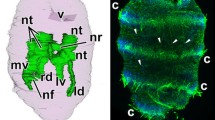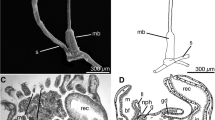Abstract
The circumoral nerve ring and the radial nerve cords (RNCs) of Eupentacta fraudatrix and Pseudocnus lubricus (Holothuroidea) were examined as an example of holothurian nervous tissue. The RNC is composed of outer ectoneural and inner hyponeural layers, which are interconnected with one another via short neural bridges. The circumoral nerve ring is purely ectoneural. Both ectoneural and hyponeural components are epithelial tubes with a thick neuroepithelium at one side. A thin ciliated non-neuronal epithelium complements the neuroepithelium to form a tube, thereby enclosing the epineural and hyponeural canals. The whole of the ectoneural and hyponeural subsystems is separated from the surrounding tissue by a continuous basal lamina. The nerve ring and the ectoneural and hyponeural parts of the radial nerves are all neuroepithelia composed of supporting cells and neurons. Supporting cells are interpreted as being glial cells. Based on ultrastructural characters, three types of neurons can be distinguished: (1) putative primary sensory neurons, whose cilium protrudes into the epineural or hyponeural canal; (2) non-ciliated neurons with swollen rough endoplasmic reticulum cisternae; (3) monociliated neurons that are embedded in the trunk of nerve fibers. Different types of synapses occur in the neuropile area. They meet all morphological criteria of classical chemical synapses. Vacuolated cells occur in the neuroepithelium of E. fraudatrix, but are absent in P. lubricus; their function is unknown. The cells of the non-neuronal epithelia that overlie the ectoneural and hyponeural canals are hypothesized to belong to the same cell type as the supporting cells of the neuroepithelium.







Similar content being viewed by others
References
Adoutte A, Balavoine G, Lartillot N, Lespinet O, Prud’homme B, de Rossa R (2000) The new animal phylogeny: reliability and implications. Proc Natl Acad Sci USA 97:4453–4456
Beklemishev VN (1964) Principles of comparative anatomy of invertebrates (in Russian). 3rd edn. Nauka, Moscow
Borisov IN, Dunaev PV, Bazhanov AN (1986) Phylogenetic principles of histological organization of animals (in Russian). Nauka, Novosibirsk
Bouland C, Massin C, Jangoux M (1982) The fine structure of the buccal tentacles of Holothuria forskali (Echinodermata, Holothuroidea). Zoomorphology 101:133–149
Byrne M (1994) Ophiuroidea. In: Harisson FW, Chia FS (eds) Microscopic anatomy of invertebrates, vol. 14. Echinodermata. Wiley-Liss, New York, pp 247–344
Chia FS, Koss R (1994) Asteroidea. In: Harisson FW, Chia FS (eds) Microscopic anatomy of invertebrates, vol. 14. Echinodermata. Wiley-Liss, New York, pp 169–246
Cobb JLS (1987) Neurobiology of the Echinodermata. In: Ali MA (eds) Nervous systems in invertebrates. Plenum Press, New York, pp 438–525
Cobb JLS (1988) A preliminary hypothesis to account for the neural basis of behaviour in echinoderms. In: Burke RD (eds) Echinoderm biology. Rotterdam, Balkema, pp 565–573
Cobb JLS (1990) Enigmas of echinoderm nervous systems. In: Anderson PAV (eds) Evolution of the first nervous systems. Plenum Press, New York, pp 329–337
Cobb JLS (1995) The nervous systems of Echinodermata: recent results and new approaches. In: Breidbach O, Kutsch W (eds) The nervous systems of invertebrates: an evolutionary and comparative approach. Birkhäuser, Basel, Boston, Berlin, pp 407–424
Cobb JLS, Stubbs T (1981) The giant neurone system in Ophiuroids. I. The general morphology of the radial nerve cords and the circumoral nerve ring. Cell Tissue Res 219:197–207
Cobb JLS, Stubbs T (1982) The giant neurone system in Ophiuroids. III. The detailed connections of the circumoral nerve ring. Cell Tissue Res 226:675–687
Cuénot L (1948) Anatomie, éthologie et systématique des Échinoderms. In: Grassé PP (ed) Traité de Zoologie. II. Masson, Paris, pp 3–363
Flammang P, Jangoux M (1992) Functional morphology of the locomotory podia of Holothuria forskali. Zoomorphology 111:167–178
von Hehn G (1970) Über den Feinbau des hyponeuralen Nervensystems des Seesternes (Asterias rubens L.). Z Zellforsch 105:137–154
Heinzeller T, Welsch U (1994) Crinoidea. In: Harrison FW, Chia FS (eds) Microscopic anatomy of invertebrates, vol. 14. Echinodermata. Wiley-Liss, New York, pp 9–148
Heinzeller T, Welsch U (2001) The echinoderm nervous system and its phylogenetic interpretation. In: Roth G, Wullimann MF (eds) Brain evolution and cognition. Wiley-Spektrum, New York, pp 41–75
Heinzeller T, Ashauer B, Mashanov V (2004) Immunolocalization of nNOS, CRF and S-100 in ecto/hyponeural cells and fibers of Ophiothrix fragilis. In: Heinzeller T, Nebelsick JH (eds) Echinoderms: München. Taylor & Francis Group, London, pp 335–338
Hyman LH (1955) The invertebrates. IV. Echinodermata. The coelomate Bilateria. McGraw-Hill Book Co. Inc., New York
Kawaguti S (1965) Electron microscopy on the radial nerve of the starfish. Biol J Okayama Univ 11:41–52
Märkel K, Röser U (1991) Ultrastructure and organization of the epineural canal and nerve cord in sea urchins (Echinodermata, Echinoida). Zoomorphology 110:267–279
Mashanov VS, Dolmatov IYu (2001) Ultrastructure of the alimentary canal in five-month-old pentactulae of the holothurian Eupentacta fraudatrix. Russ J Mar Biol 27:320–328
Mashanov VS, Dolmatov IYu, Frolova LT (2004) Structure of the digestive tube in the holothurian Eupentacta fraudatrix (Holothuroidea: Dendrochirota). Russ J Mar Biol 30:366–374
McKenzie JD (1987) The ultrastructure of the tentacles of eleven species of dendrochirote holothurians studied with special reference to the surface coats and papillae. Cell Tissue Res 248:187–199
McKenzie JD (1988) Ultrastructure of the tentacles apodous holothurian Leptosynapta spp. With special reference to the epidermis and surface coats. Cell Tissue Res 251:387–397
Peters BH (1985) The innervations of spines in the sea-urchin Echinus esculentus L. An electron-microscopic study. Cell Tissue Res 239:219–228
Peters BH, Campbell AC (1987) Morphology of the nervous and muscular system in the heads of pedicellariae from the sea urchin Echinus esculentus L. J Morphol 193:35–51
Smiley S (1994) Holothuroidea. In: Harisson FW, Chia FS (eds) Microscopic anatomy of invertebrates, vol. 14. Echinodermata. Wiley-Liss, New York, pp 401–472
Smith JE (1965) Echinodermata. In: Bullock TH, Horridge GA (eds) Structure and function in the nervous system of invertebrates, vol. 11. Freeman & Co., San Francisco, pp 1520–1558
Smith JE (1966) The form and function of the nervous system. In: Boolootian RA (ed) Echinoderm physiology. Wiley, New York, pp 503–512
Smith AB (1984) Classification of the Echinodermata. Paleontology 27(3):431–459
Stubbs T, Cobb JLS (1981) The giant neuron system in Ophiuroids. II. The hyponeural motor tracts. Cell Tissue Res 220:373–385
VandenSpiegel D, Jangoux M (1987) Cuvierian tubules of the holothuroid Holothuria forskali: a morphofunctional study. Mar Biol 96:263–275
VandenSpiegel D, Jangoux M (1993) Fine structure and behavior of the so-called Cuvierian organs in the holothuroid genus Actinopyga (Echinodermata). Acta Zool 74:43–50
VandenSpiegel D, Flammang P, Fourmeau D, Jangoux M (1995) Fine structure of the dorsal papillae in the holothurioid Holothuria forskali (Echinodermata). Tissue Cell 27:457–465
Viehweg J, Naumann WW, Olsson R (1998) Secretory radial glia cells in the ectoneural system of the sea star Asterias rubens (Echinodermata). Acta Zool 79:119–131
Acknowledgments
We are grateful to Philip Lambert of the Royal British Columbia Museum Victoria, Canada, for providing us with fixed specimens of juvenile P. lubricus and to Beate Aschauer (LMU, Munich) for her inestimable technical assistance. We are especially indebted to Prof. I.C. Wilkie (Glasgow Caledonian University, Scotland) for his critical reading of the manuscript. The work was supported by the grant of the Russian Foundation for Basic Research (project no. 05-04-48715) to I.Yu. Dolmatov and by the DAAD scholarship to V.S. Mashanov.
Author information
Authors and Affiliations
Corresponding author
Rights and permissions
About this article
Cite this article
Mashanov, V.S., Zueva, O.R., Heinzeller, T. et al. Ultrastructure of the circumoral nerve ring and the radial nerve cords in holothurians (Echinodermata). Zoomorphology 125, 27–38 (2006). https://doi.org/10.1007/s00435-005-0010-9
Received:
Accepted:
Published:
Issue Date:
DOI: https://doi.org/10.1007/s00435-005-0010-9




